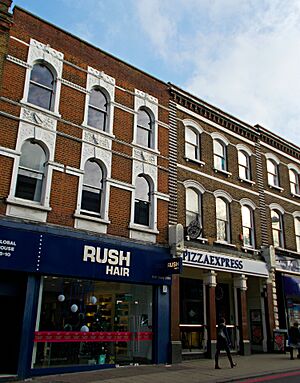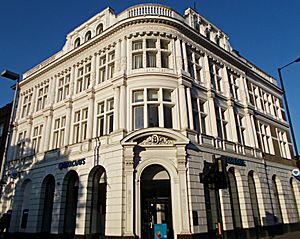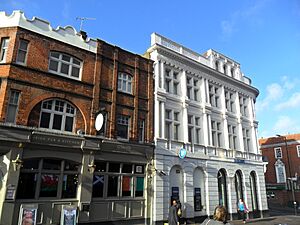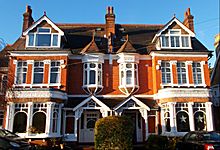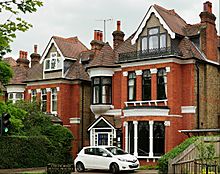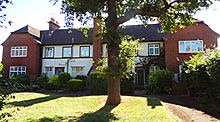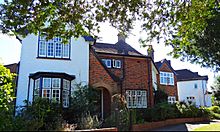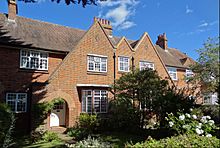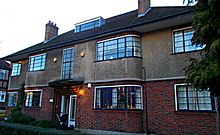Conservation areas in Sutton, London facts for kids
Quick facts for kids Conservation areas in Sutton, London |
|
|---|---|
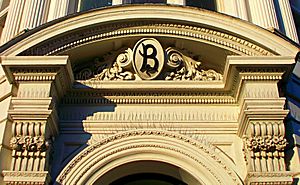
The fancy entrance of the Barclay's Bank building in Sutton High Street
|
|
| Location | Sutton, London Borough of Sutton |
Imagine a special part of a town that is protected because of its history or unique look. These are called conservation areas. They help keep old buildings and pretty streets safe for the future.
In the town of Sutton, there are four of these special areas. One is right in the town centre, called the Sutton Town Centre High Street Crossroads Conservation Area. The other three are places where people live: Grove Avenue, Landseer Road, and the Sutton Garden Suburb.
Each area has its own special style. The High Street has colourful Victorian buildings. Grove Avenue features modern and half-timbered houses. Landseer Road has large, detailed Edwardian homes. The Sutton Garden Suburb is part of a movement that created green, planned communities.
Contents
Sutton Town Centre High Street Crossroads Conservation Area
The Sutton Town Centre High Street Crossroads Conservation Area was made a special protected place on 9 May 2011. This happened after people looked closely at the town centre. They saw how important the old roads and buildings around the crossroads of Cheam Road/Carshalton Road and Sutton High Street were.
This conservation area focuses on the historic crossroads. It stretches from the train station down to Trinity Square. It also includes part of Grove Road, where a masonic hall from the late 1800s stands. Two churches, Sutton Baptist Church and Trinity Church, are also inside this area. The police station on Carshalton Road, built during the Edwardian era, is included too.
Local experts noted that the buildings, especially their top floors, were worth saving. They decided that the area's history and beautiful architecture made it perfect for conservation status. This status helps guide people on how to keep and improve the historic look of the area. One expert, Gordon Rookledge, described the High Street's buildings as having "vivid, Victorian, polychrome brick and stone façades," meaning they are colourful and detailed.
What is a Heritage Action Zone?
In March 2017, Sutton town centre became one of the first ten "Heritage Action Zones." This is a special title given by Historic England. Being a Heritage Action Zone helps get money and support to improve historic places. The goal is to help the local economy grow by making the historic areas even better. This means that when new buildings are planned, they must fit in with the town's unique old style.
Landseer Road Conservation Area
The Landseer Road Conservation Area includes Landseer Road itself. It also covers most of Bridgefield Road, York Road, Derby Road, Cecil Road, and Salisbury Avenue. Short parts of Cheam Road and Grove Road are also included.
This area was made a conservation area in 1992. It is about nine hectares in size and has 138 homes. It sits between Sutton town centre and Cheam Village. Most of the houses here are large, detached villas. The grand size of these homes is a key feature. The area is also surrounded by old trees and grassy areas.
Building on these roads started in the late 1800s. All the homes were finished by 1913. According to Gordon Rookledge, these roads have the "finest, detailed Edwardian detached and semi-detached houses" in the Sutton area.
The Sutton Garden Suburb Conservation Area
The Sutton Garden Suburb is located in Benhilton, in the northern part of Sutton. This area was the first in Sutton to become a conservation area, back in 1989. It was inspired by the Arts and Crafts movement, which focused on traditional craftsmanship and simple designs.
Thomas Wall, famous for his sausages and ice cream, helped develop this suburb between 1912 and 1914. The Sutton Garden Suburb was part of the garden city movement. This idea, started by Ebenezer Howard, aimed to create new towns that combined city life with green spaces. It was similar to the Hampstead Garden Suburb in north London.
Frederick Cavendish Pearson designed the suburb for Rose Hill Park Limited. The design included houses and green spaces that worked together. Some homes were hidden around small greens, while others were along tree-lined streets. The original plan was for 1,000 houses, with recreation areas and a clubhouse.
Tennis courts and a clubhouse were built in the middle of the Suburb. However, during the Second World War, much of the land was used as a victory garden. These were gardens where people grew food to help with wartime shortages. Local residents continued to use the land for growing food until 1997. The land is now unused and has become a home for local wildlife. It is officially marked as an Urban Green Space.
The first houses were built at Oak Close, then Meadow Close, Hawthorne Close, and Horseshoe Green. Between 1912 and 1914, 79 houses were started following Cavendish's plans. More houses began in Woodend in 1914. In 1915, 55 more houses were being built in Greenhill and Aultone Way.
However, the First World War stopped new house building in 1915. After the war, money problems meant that the remaining land was sold cheaply. This is why you can see different styles of houses in the area today. Many semi-detached homes and bungalows were built on these plots later. Cavendish Pearson also designed houses for private owners in the Suburb. He later helped design the nearby St Helier estate. Cavendish Pearson himself lived in two houses he designed in the Suburb.
Grove Avenue Conservation Area
The Grove Avenue Conservation Area was built as a private housing estate. This happened in the 1920s or early 1930s. It is located between Grove Road and Cheam Road, close to the Landseer Road Conservation Area.
The buildings here are made up of single blocks. Each block contains four apartments, called maisonettes. They all have a balanced look facing the road. These blocks are built in two different styles: modernist or half-timbered. Many of the original details are still there. These include iron-framed windows, hand-painted number signs, garage fronts, front garden walls, and the original gate-piers for the estate.


